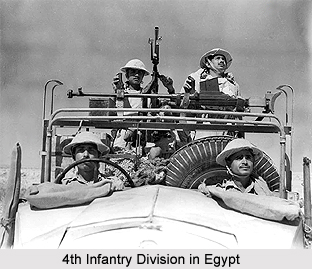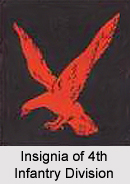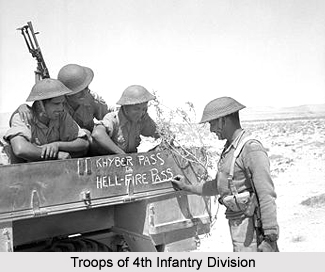 The Indian 4th Infantry Division was one of the former infantry formations of the British Indian Army. It was raised by the British Empire in India in 1939. The unit was the first Indian army regiments to serve abroad during World War II. The division included mainly English Officers and native personnel in various other ranks. However, there were some Indian officers in the ranks of Major or Captain. The Indian 4th Infantry Division participated in a number of British conquests in Italy; North Africa; Syria; and Sudan and Eritrea in East Africa. The regiment was also known as the Red Eagle Division. After the Indian Independence, the infantry unit became a part of the Modern Indian Army.
The Indian 4th Infantry Division was one of the former infantry formations of the British Indian Army. It was raised by the British Empire in India in 1939. The unit was the first Indian army regiments to serve abroad during World War II. The division included mainly English Officers and native personnel in various other ranks. However, there were some Indian officers in the ranks of Major or Captain. The Indian 4th Infantry Division participated in a number of British conquests in Italy; North Africa; Syria; and Sudan and Eritrea in East Africa. The regiment was also known as the Red Eagle Division. After the Indian Independence, the infantry unit became a part of the Modern Indian Army.
Military Operations of Indian 4th Infantry Division
The Indian 4th Infantry Division provided significant service during the Second World War. The troops were in the front line during the British campaigns in the Mediterranean theatre. During the operations, the British 14th Infantry Brigade and the British 16th Infantry Brigade were attached to the Indian 4th Infantry Division in 1940. The regiment fought in Operation Compass in Egypt in December 1940, as part of the Western Desert Force. The 11th Brigade of the 4th Infantry Division was attached with the 7th Royal Tank Regiment and it defeated the Italian Maletti Group at the Nibiewa Camp.
The troops were stationed in British Sudan in December 1940 to participate in the East African campaign. It was attached with the Indian 5th Infantry Division and fought against the much stronger Italian forces. The infantry division also fought in the battles at Keren in Eritrea and defeated around 42 Italian battalions. In the 1941, Major General Frank Messervy was appointed as the Commanding Officer of the unit. Later in 1941, part of the Indian 4th Infantry Division was sent to Syria and participated in the advance on Damascus during the Syria- Lebanon Campaign. The 4th Mechanized Brigade was attached to the infantry unit in June 1941. The troops fought valiantly during the battle which advanced to Tobruk. In December 1941, Major General Francis Tuker was assigned as the Commanding Officer of the military force.
 Later in April 1942, detachments of the unit were sent to various locations. The 7th Brigade was stationed in Cyprus, the Central India Horse was sent to Iraq, 11th Brigade was posted in Suez Canal Zone and 5th Brigade was stationed in Syria. The 11th Brigade was attached with the Indian 5th Infantry Division in May 1942 and participated in the conflict in Tobruk. However it was captured by during the siege of Tobruk. The Indian 4th Infantry Division was assembled back in October 1942 and the 161st Brigade was attached to the unit as a replacement of the 11th Brigade. The troops then fought in the Second Battle of El Alamein.
Later in April 1942, detachments of the unit were sent to various locations. The 7th Brigade was stationed in Cyprus, the Central India Horse was sent to Iraq, 11th Brigade was posted in Suez Canal Zone and 5th Brigade was stationed in Syria. The 11th Brigade was attached with the Indian 5th Infantry Division in May 1942 and participated in the conflict in Tobruk. However it was captured by during the siege of Tobruk. The Indian 4th Infantry Division was assembled back in October 1942 and the 161st Brigade was attached to the unit as a replacement of the 11th Brigade. The troops then fought in the Second Battle of El Alamein.
The Indian 4th Infantry Division later took part in the Battle of Tunisia and fought with distinction in 1943. The troops also participated in other major conflicts in Enfidaville, Wadi Akarit, Tobruk and Benghazi. In January 1944, the infantry division was sent to Italy and participated in the Italian Campaign. It served also during the second Battle of Monte Cassino under the command of Brigadier Harry Dimoline. The troops later provided service during the third battle in March 1944 under the leadership of Major General Alexander Galloway. However, the unit suffered heavy casualties during the conflict. After the fourth battle in May 1944, the Indian 4th Infantry Division participated in the advance from Cassino to the Trasimene Line in Central Italy.
During the Italian Campaign of World War II, the 9th Armoured Brigade was merged with the unit in July 1944. Afterwards it was stationed in Greece. After the culmination of the war, the troops were sent back to British India from Greece in 1945. Throughout the Second World War, the Indian 4th Infantry Division was awarded with more than 1,000 Military Honours and Awards, including George Crosses and Victoria Crosses.
Development of Indian 4th Infantry Division
The Indian 4th Infantry Division was developed into the Punjab Boundary Force in 1947. Major General T.W. Rees was appointed as the Commander of the regiment. The force was formed on 17th July 1947 and became operation on 1st August 1947. However it was dissolved due to ineffectiveness on 1st September 1947.
After the Partition of India, the British Indian Army was divided among the Union of India and the Dominion of Pakistan. Consequently, the Indian 4th Infantry Division, also known as Red Eagle, was assigned to the modern Army of independent India. It consisted of the 114th Indian Infantry Brigade, 43rd Lorry Brigade, 14th Parachute Brigade, 11th Indian Infantry Brigade and the 5th Indian Infantry Brigade. The 123rd Indian Infantry Brigade, 77th Parachute Brigade and the 50th Parachute Brigade were also attached to the army unit.
 The troops took part in the Sino-Indian War of 1962 and also fought on the Bangladesh front during the Indo-Pakistani War in 1971. Later the regiment came under the I Corps of Indian Army and the Central Command. The headquarters of the Red Eagle Division is presently situated in Allahabad.
The troops took part in the Sino-Indian War of 1962 and also fought on the Bangladesh front during the Indo-Pakistani War in 1971. Later the regiment came under the I Corps of Indian Army and the Central Command. The headquarters of the Red Eagle Division is presently situated in Allahabad.
General Officer Commanding of Indian 4th Infantry Division
The General Officers who were appointed as the Commanding Officers of the unit are listed below-
* Major General The Honorary P. Gerald Scarlett (October 1939 to January 1940)
* Major General Philip Neame (February 1940 to August 1940)
* Major General Noel Beresford Peirse (August 1940 to April 1941)
* Major General Frank Messervy (April 1941 to December 1941)
* Major General Francis Tuker (December 1941 to February 1944)
* Brigadier Harry Dimoline (February 1944 to March 1944)
* Major General Alexander Galloway (March 1944)
* Major General Arthur Holworthy (March 1944 to January 1945)
* Major General Charles Boucher (January 1945 to August 1945)
Formation of Indian 4th Infantry Division
The Indian 4th Infantry Division included several brigades, some of which are mentioned as follows-
* Central India Horse
* Royal Artillery
* Royal Horse Artillery
* King George`s Own Bengal Sappers and Miners
* Queen Victoria`s Own Madras Sappers and Miners
* Royal Bombay Sappers and Miners
* Queen Victoria`s Own Madras Sappers and Miners
* 4th Indian Division Signals
* 1st Machine Gun Battalion Royal Northumberland Fusiliers
* Machine Gun Battalion 6th Rajputana Rifles
* 5th Indian Infantry Brigade
* 7th Indian Infantry Brigade
* 11th Indian Infantry Brigade
Apart from these, the British Indian infantry division also included several support units. These are listed below-
* Royal Indian Army Service Corps
* Medical Services
* Indian Army Ordnance Corps
* Indian Electrical & Mechanical Engineers
Assigned Brigades of Indian 4th Infantry Division
There were several brigades that were attached or assigned to the Indian 4th Infantry Division during the Second World War. These are mentioned as follows-
* 4th New Zealand Infantry Brigade
* 10th Indian Infantry Brigade
* British 23rd Infantry Brigade
* British 161st Infantry Brigade
* British 22nd Infantry Brigade
* 1st South African Infantry Brigade
* 161st Indian Infantry Brigade
* British 201st Guards Motor Brigade
* 11th Canadian Infantry Brigade



















